Citoyenne Collection
"Citoyenne: Embodying the Spirit of Revolutionary France" In the midst of tumultuous times, one woman stands tall in her prison cell
All Professionally Made to Order for Quick Shipping
"Citoyenne: Embodying the Spirit of Revolutionary France" In the midst of tumultuous times, one woman stands tall in her prison cell. Citizen Tallien, with her cut hair in hand, symbolizes the resilience and determination of a true citoyenne. Painted in 1796, this oil on canvas captures the essence of a brave individual who fought for liberty. But it is not just individuals who embody the spirit of being a citoyenne; entire houses can be seen as symbols too. The House of the Citizen of Brunoy, designed by architect Bullee and located in Champs-Elysees, represents an architectural homage to citizenship. It stands proudly as a testament to equality and unity. During this era, even those born into royalty embraced their role as citizens. Royalty-born citizens emerged from their privileged backgrounds to actively participate in shaping France's destiny. Their commitment to progress was recognized through medals awarded on October 30th, 1789 - honoring their dedication to becoming exemplary members of society. The concept of being a citizen extended beyond personal achievements; it encompassed civic duty and engagement with fellow Parisians. In September 1789 at the Constituent Assembly, citizens gathered to honor their jewels - precious possessions that represented solidarity among them all. As guardians of law and order within society, directors at the police department were also considered fellow citizens themselves. They took up positions ensuring safety while maintaining harmony amongst all inhabitants. One iconic establishment that epitomized citizenship was none other than Paris City Hall itself – its creation marked an important milestone towards democratic governance. This symbolic building became a hub where ideas were exchanged freely between engaged citizens striving for progress. Fashion played no small part either when defining what it meant to be a citoyenne during this period. Female costumes reflected both elegance and practicality – women dressed fashionably yet comfortably while embracing their newfound roles as active participants in public life.


